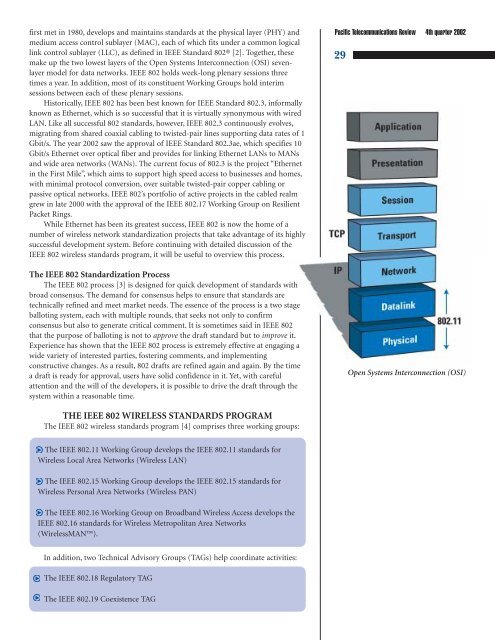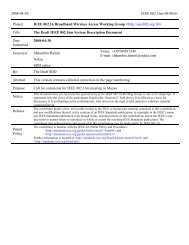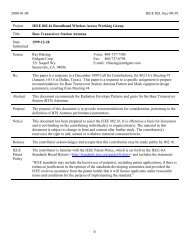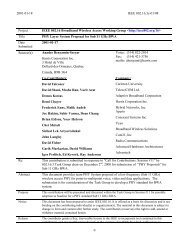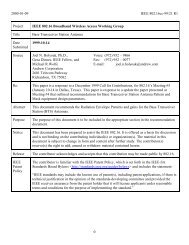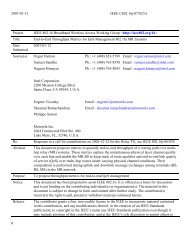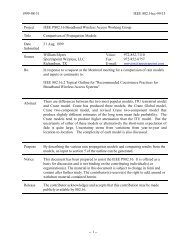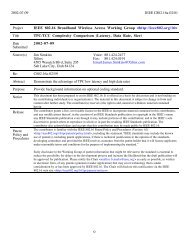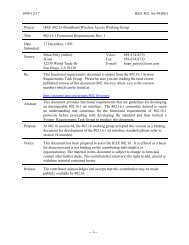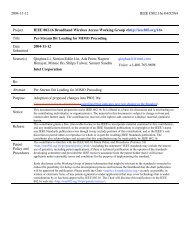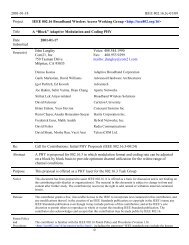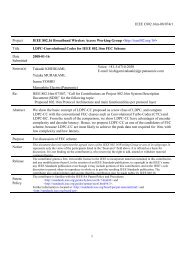Download - LMSC, LAN/MAN Standards Committee
Download - LMSC, LAN/MAN Standards Committee
Download - LMSC, LAN/MAN Standards Committee
You also want an ePaper? Increase the reach of your titles
YUMPU automatically turns print PDFs into web optimized ePapers that Google loves.
first met in 1980, develops and maintains standards at the physical layer (PHY) and<br />
medium access control sublayer (MAC), each of which fits under a common logical<br />
link control sublayer (LLC), as defined in IEEE Standard 802® [2]. Together, these<br />
make up the two lowest layers of the Open Systems Interconnection (OSI) sevenlayer<br />
model for data networks. IEEE 802 holds week-long plenary sessions three<br />
times a year. In addition, most of its constituent Working Groups hold interim<br />
sessions between each of these plenary sessions.<br />
Historically, IEEE 802 has been best known for IEEE Standard 802.3, informally<br />
known as Ethernet, which is so successful that it is virtually synonymous with wired<br />
<strong>LAN</strong>. Like all successful 802 standards, however, IEEE 802.3 continuously evolves,<br />
migrating from shared coaxial cabling to twisted-pair lines supporting data rates of 1<br />
Gbit/s. The year 2002 saw the approval of IEEE Standard 802.3ae, which specifies 10<br />
Gbit/s Ethernet over optical fiber and provides for linking Ethernet <strong>LAN</strong>s to <strong>MAN</strong>s<br />
and wide area networks (WANs). The current focus of 802.3 is the project “Ethernet<br />
in the First Mile”, which aims to support high speed access to businesses and homes,<br />
with minimal protocol conversion, over suitable twisted-pair copper cabling or<br />
passive optical networks. IEEE 802’s portfolio of active projects in the cabled realm<br />
grew in late 2000 with the approval of the IEEE 802.17 Working Group on Resilient<br />
Packet Rings.<br />
While Ethernet has been its greatest success, IEEE 802 is now the home of a<br />
number of wireless network standardization projects that take advantage of its highly<br />
successful development system. Before continuing with detailed discussion of the<br />
IEEE 802 wireless standards program, it will be useful to overview this process.<br />
The IEEE 802 Standardization Process<br />
The IEEE 802 process [3] is designed for quick development of standards with<br />
broad consensus. The demand for consensus helps to ensure that standards are<br />
technically refined and meet market needs. The essence of the process is a two stage<br />
balloting system, each with multiple rounds, that seeks not only to confirm<br />
consensus but also to generate critical comment. It is sometimes said in IEEE 802<br />
that the purpose of balloting is not to approve the draft standard but to improve it.<br />
Experience has shown that the IEEE 802 process is extremely effective at engaging a<br />
wide variety of interested parties, fostering comments, and implementing<br />
constructive changes. As a result, 802 drafts are refined again and again. By the time<br />
a draft is ready for approval, users have solid confidence in it. Yet, with careful<br />
attention and the will of the developers, it is possible to drive the draft through the<br />
system within a reasonable time.<br />
Pacific Telecommunications Review 4th quarter 2002<br />
29<br />
Open Systems Interconnection (OSI)<br />
THE IEEE 802 WIRELESS STANDARDS PROGRAM<br />
The IEEE 802 wireless standards program [4] comprises three working groups:<br />
The IEEE 802.11 Working Group develops the IEEE 802.11 standards for<br />
Wireless Local Area Networks (Wireless <strong>LAN</strong>)<br />
The IEEE 802.15 Working Group develops the IEEE 802.15 standards for<br />
Wireless Personal Area Networks (Wireless PAN)<br />
The IEEE 802.16 Working Group on Broadband Wireless Access develops the<br />
IEEE 802.16 standards for Wireless Metropolitan Area Networks<br />
(Wireless<strong>MAN</strong>).<br />
In addition, two Technical Advisory Groups (TAGs) help coordinate activities:<br />
The IEEE 802.18 Regulatory TAG<br />
The IEEE 802.19 Coexistence TAG


